Related Research Articles
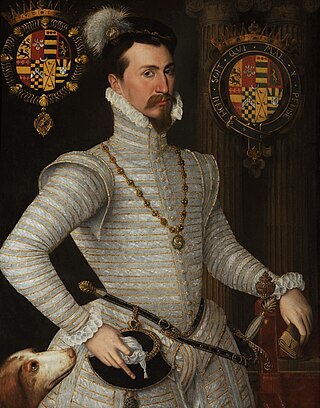
Robert Dudley, 1st Earl of Leicester, was an English statesman and the favourite of Elizabeth I from her accession until his death. He was a suitor for the queen's hand for many years.
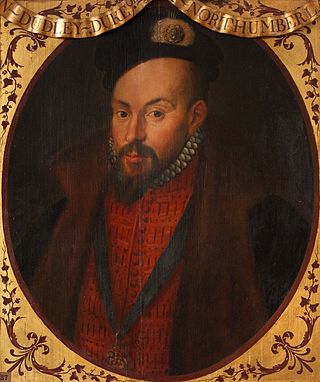
John Dudley, 1st Duke of Northumberland was an English general, admiral, and politician, who led the government of the young King Edward VI from 1550 until 1553, and unsuccessfully tried to install Lady Jane Grey on the English throne after the King's death. The son of Edmund Dudley, a minister of Henry VII executed by Henry VIII, John Dudley became the ward of Sir Edward Guildford at the age of seven. Dudley grew up in Guildford's household together with his future wife, Guildford's daughter Jane, with whom he was to have 13 children. Dudley served as Vice-Admiral and Lord Admiral from 1537 until 1547, during which time he set novel standards of navy organisation and was an innovative commander at sea. He also developed a strong interest in overseas exploration. Dudley took part in the 1544 campaigns in Scotland and France and was one of Henry VIII's intimates in the last years of the reign. He was also a leader of the religious reform party at court.

Sir Robert Dudley was an English explorer and cartographer. In 1594, he led an expedition to the West Indies, of which he wrote an account. The illegitimate son of Robert Dudley, 1st Earl of Leicester, he inherited the bulk of the Earl's estate in accordance with his father's will, including Kenilworth Castle. In 1603–1605, he tried unsuccessfully to establish his legitimacy in court. After that he left England forever, finding a new existence in the service of the grand dukes of Tuscany. There, he worked as an engineer and shipbuilder, and designed and published Dell'Arcano del Mare (1645-1646), the first maritime atlas to cover the whole world. He was also a skilled navigator and mathematician. In Italy, he styled himself "Earl of Warwick and Leicester", as well as "Duke of Northumberland", a title recognized by Emperor Ferdinand II.
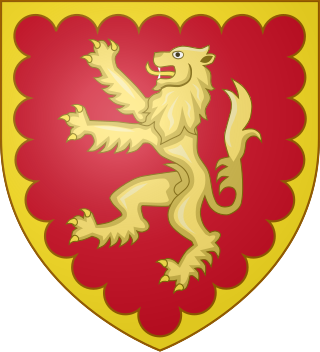
The title of Viscount Lisle has been created six times in the Peerage of England. The first creation, on 30 October 1451, was for John Talbot, 1st Baron Lisle. Upon the death of his son Thomas at the Battle of Nibley Green in 1470, the viscountcy became extinct and the barony abeyant.
John Dudley, 2nd Earl of Warwick, KB was an English nobleman and the heir of John Dudley, 1st Duke of Northumberland, leading minister and regent under King Edward VI from 1550–1553. As his father's career progressed, John Dudley respectively assumed his father's former titles, Viscount Lisle and Earl of Warwick. Interested in the arts and sciences, he was the dedicatee of several books by eminent scholars, both during his lifetime and posthumously. His marriage to the former Protector Somerset's eldest daughter, in the presence of the King and a magnificent setting, was a gesture of reconciliation between the young couple's fathers. However, their struggle for power flared up again and ended with the Duke of Somerset's execution. In July 1553, after King Edward's death, Dudley was one of the signatories of the letters patent that attempted to set Lady Jane Grey on the throne of England, and took arms against Mary Tudor, alongside his father. The short campaign did not see any military engagements and ended as the Duke of Northumberland and his son were taken prisoners at Cambridge. John Dudley the younger was condemned to death yet reprieved. He died shortly after his release from the Tower of London.
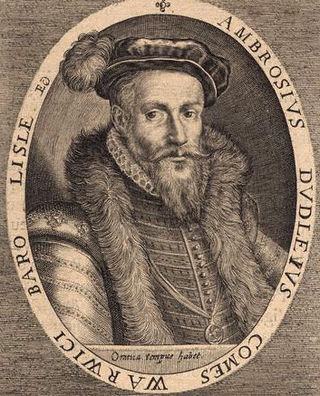
Ambrose Dudley, 3rd Earl of Warwick, KG was an English nobleman and general, and an elder brother of Queen Elizabeth I's favourite, Robert Dudley, Earl of Leicester. Their father was John Dudley, Duke of Northumberland, who led the English government from 1550–1553 under King Edward VI and unsuccessfully tried to establish Lady Jane Grey on the English throne after the King's death in July 1553. For his participation in this venture, Ambrose Dudley was imprisoned in the Tower of London and condemned to death. Reprieved, his rehabilitation came after he fought for King Philip in the Battle of St. Quentin.
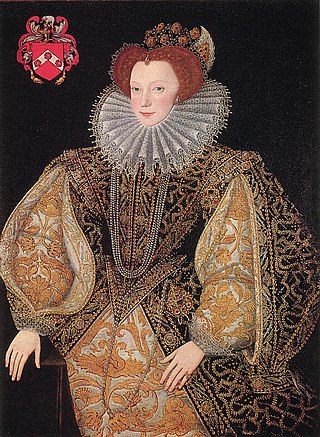
Lettice Knollys, Countess of Essex and Countess of Leicester, was an English noblewoman and mother to the courtiers Robert Devereux, 2nd Earl of Essex, and Lady Penelope Rich. By her second marriage to Elizabeth I's favourite, Robert Dudley, Earl of Leicester, she incurred the Queen's unrelenting displeasure.

Amy, Lady Dudley was the first wife of Robert Dudley, Earl of Leicester, favourite of Elizabeth I of England. She is primarily known for her death by falling down a flight of stairs, the circumstances of which have often been regarded as suspicious. Amy Robsart was the only child of a substantial Norfolk gentleman. In the vernacular of the day, her name was spelled as Amye Duddley.
Douglas, Lady Sheffield, was an English noblewoman, the lover of Robert Dudley, 1st Earl of Leicester and mother by him of explorer/cartographer Sir Robert Dudley, an illegitimate son.

Sir Thomas Arundell of Wardour Castle in Wiltshire was a Cornish administrator and alleged conspirator.

John Harington, 1st Baron Harington of Exton in Rutland, was an English courtier and politician.
Sir Thomas Heneage PC was an English politician and courtier at the court of Elizabeth I.
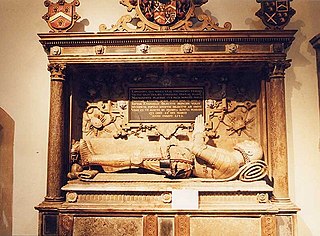
Sir Edward Horsey was a conspirator against Queen Mary, then a soldier, ambassador and courtier under Queen Elizabeth.
Anne DudleyCountess of Warwick (1538–1588) was a writer during the sixteenth century in England, along with her sisters Lady Margaret Seymour and Lady Jane Seymour. She was the eldest daughter of Edward Seymour, 1st Duke of Somerset, who from 1547–1549 was the Lord Protector of England during the minority of her cousin, Edward VI. Being educated by the French humanist and poet, Nicholas Denisot, Anne Seymour with her sisters Margaret and Jane composed 103 Latin distichs for the tomb of Marguerite de Navarre, which were published in France as Hecatodistichon. The first edition of March 1550 was followed by a second in 1551, containing significant alterations.
Sir Henry Killigrew was a Cornish diplomat and an ambassador for the Kingdom of England in the sixteenth century. He was several times employed by Elizabeth I in Scottish affairs and served as one of the English appointees to the Council of State of the Netherlands in the United Provinces in 1586 and 1587–1589. He served as a Member of Parliament for Newport & Launceston in 1553, for Saltash in 1563, and for Truro in 1571–2.
Jane Dudley, Duchess of Northumberland was an English courtier. She was the wife of John Dudley, 1st Duke of Northumberland, and mother of Guildford Dudley and Robert Dudley, 1st Earl of Leicester. Having grown up with her future husband, who was her father's ward, she married at about age 16. They had 13 children.

Lady Mary Sidney was a lady-in-waiting at the court of Elizabeth I, wife of Sir Henry Sidney and the mother of Sir Philip Sidney and Mary Sidney Herbert, Countess of Pembroke. She was daughter of John Dudley, Duke of Northumberland, and sister of Elizabeth's favourite, Robert Dudley, Earl of Leicester.
Sir Edmund Carey was an English MP from 1584 to 1614.
John Dudley, of Stoke Newington, Middlesex, was an English politician.
Henry Dudley was an English soldier and an elder brother of Queen Elizabeth I's favourite, Robert Dudley, Earl of Leicester. Their father was John Dudley, Duke of Northumberland, who led the English government from 1550 to 1553 under Edward VI and unsuccessfully tried to establish Lady Jane Grey on the English throne after the King's death in July 1553. For his participation in this venture Henry Dudley was imprisoned in the Tower of London and condemned to death, but pardoned.
References
- 1 2 Jackson, W. (1888). "The Dudleys of Yanworth". Transactions of the Cumberland and Westmorland Historical and Archaeological Society. 9: 318–332.
- 1 2 Adams, Simon (2002). Leicester and the Court. p. 154.
- ↑ Adams 2002, p. 169.
- 1 2 "DUDLEY, Thomas (d.1593), of London" . Retrieved 12 January 2024.